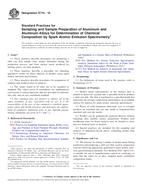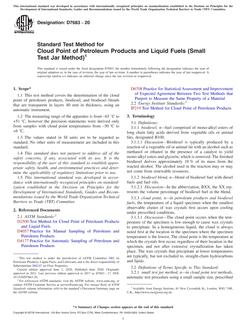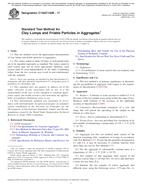1.1 In studying a test method, it is necessary to consider the effect of environmental factors on the results obtained using the test method. If this effect is not considered, the results from the original developmental work on the test method may not be as accurate as expected.The purpose of a ruggedness test is to find the variables (experimental factors) that strongly influence the measurements provided by the test method, and to determine how closely these variables need to be controlled. Ruggedness tests do not determine the optimum conditions for the test method.
1.2 The experimental designs most often used in ruggedness testing are the so called “Plackett-Burman” designs (1). Other experimental designs also can be used. This guide, however, will restrict itself to Plackett-Burman designs with two levels per variable because these designs are particularly easy to use and are efficient in developing the information needed for improving test methods. The designs require the simultaneous change of the levels of all of the variables, and allow the determination of the separated effects of each of the variables on the measured results. In ruggedness tests the two levels for each variable are set so as not to be greatly different. For such situations, the calculated effect for any given variable is generally not greatly affected by changes in the level of any of the other variables. A detailed example involving glass electrode measurements of the pH of dilute acid solutions is used to illustrate ruggedness test procedures. A method is presented for evaluating the experimental uncertainties.
1.3 The information in this guide is arranged as follows:
| Section | |
| Scope | 1 |
| Referenced Documents | 2 |
| Terminology | 3 |
| Summary of Guide | 4 |
| Significance and Use | 5 |
| Plackett-Burman Designs Applied to Ruggedness Tests | 6 |
| Plackett-Burman Design Calculations | 7 |
| Plackett-Burman Design Considerations | 8 |
| Interpretation of Results | 9 |
| Example | 10 |
| Testing Effects from Repeated (pH) Experiments | 11 |
| Controllable versus Uncontrollable Factors | 12 |
| Additional Information | 13 |
| Tables | |
| Figures | |
| Appendixes | |
| Additional Plackett-Burman | Appendix X1. |
| DesignsShort-Cut CalculationsReferences | X1.3. |
1.4 This standard does not purport to address all of the safety concerns, if any, associated with its use. It is the responsibility of the user of this standard to establish appropriate safety and health practices and determine the applicability of regulatory limitations prior to use.
Product Details
- Published:
- 10/10/2002
- Number of Pages:
- 7
- File Size:
- 1 file , 74 KB
- Redline File Size:
- 2 files , 130 KB


